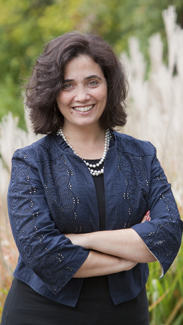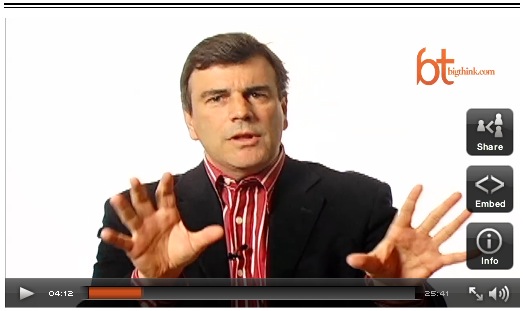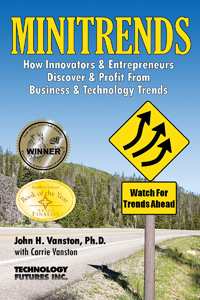What’s the Hottest New Tech Trend? Ranking Hot New Tech Trends
October 28, 2010
 The National Aeronautics and Space Administration, better known as NASA, has a new mission. No, I don’t mean we’re going to Mars, although that certainly is on NASA’s radar. Rather, NASA seeks to become the information technology (IT) leader for the U.S. government.
The National Aeronautics and Space Administration, better known as NASA, has a new mission. No, I don’t mean we’re going to Mars, although that certainly is on NASA’s radar. Rather, NASA seeks to become the information technology (IT) leader for the U.S. government.
This new mission was revealed by NASA’s chief administrator Charles F. Bolden last month, when he opened NASA’s first Information Technology Summit. Among the luminaries making presentations at the summit were:
- James Stikeleather, Chief Innovation Officer, Dell Services
- Mark Bregman, Chief Technology Officer, Symantec
- David W. Cearley, Vice President and Gartner Fellow in Research, Gartner, Inc.
- Vint Cerf, Vice President & Chief Internet Evangelist, Google
- Vivek Kundra, Chief Information Officer, United States of America
NASA has kindly made the videos of these hour-long presentations freely available online. Anyone interested in IT trends is encouraged to review them. Of keen interest to Minitrends Adventurers is James Stikeleather’s take on the future of IT. Internet immortal, Alexander Wolfe, the editor-in-chief of InformationWeek.com famous for reporting on the Pentium “floating point” bug, recently spoke with Stikeleather and came away with this interesting perspective:
[…C]ompanies are attempting to codify the processes through which innovation can be nurtured. More important than ideas, which quite frankly are cheap, is the ability to pick which concepts are worthy of the heavy investment of time, money, and corporate mindshare required to take them to productization.
Leading the pack here is Dell. At the InformationWeek 500 Conference, I spoke with Chief Innovation Officer James Stikeleather, who is working to establish and spread a methodology for innovation throughout the computer powerhouse.
This desire to handicap ideas based on the ability to bring them profitably to market is at the core of MINITRENDS, the new book by John and Carrie Vanston. The authors lay out a systematic process for evaluating ideas in order to uncover those with a development time frame of two to five years.
Wolfe made his remarks in a column a few days ago on The Top 5 Tech Trends in 2011. Along with the need to grade ideas based on their short-term feasibility, Wolfe sees these as the big IT issues in the coming year:
- Data Visualization, to make sense of the overwhelming amount of information businesses are collecting and have stored up.
- Rebellion Against Maintenance Fees, by businesses that are tired of paying ransom to software companies for maintenance contracts they barely use.
- Enterprise 2.0, the integration of social networking into business enterprises, which Wolfe sees as a mixed bag but a major issue in the coming year.
- The Internet Is Making Us Stupid, by reducing attention spans to the point where reading Wolfe’s column feels like reading War and Peace.
Wolfe’s top tech list is quite a bit different from the other year-end lists we’ve been covering here on the Minitrends Blog. While most forecasters are focused on cloud computing and mobile technology, Wolfe’s list has a decidedly human element to it. He sees most trends coming not from a lust for the new, but from a need to fix a pressing problem. The Vanstons also cite alleviating pain, rather than pursuing pleasure, as a major driving force behind new technology.
As we continue our year-end look at tech trends, we’re anxious to hear your top picks. Will the hot trends for the new year propel us into a new world or shield us from it? We welcome your comments.
STEVE O’KEEFE
News Editor, Minitrends Blog
Source: NASA Information Technology Summit Videos, NASA, 08/10
Source: “Top 5 Tech Trends For 2011,” InformationWeek.com, 10/23/10
Image by http2007, used under Creative Commons license.
The Future of Futurists Is Uncertain
October 22, 2010
In a pair of interesting articles for MIT Technology Review, one of the best futurists in the business, Tom Simonite, says the future for futurists is not what it used to be. It appears that computers might be getting better at forecasting the future than futurists are.
Simonite is no slouch when it comes to predicting trends. Not only is he the IT editor for MIT Technology Review, he’s also the online technology reporter for NewScientist. On October 4, Simonite reviewed a new search technology by startup company Recorded Future that doesn’t just find what’s out there, but what will be out there, related to any search term.
The search engine works by looking at patterns of when a company says it will release a new product, for example, compared with the actual dates of product releases. The search engine can then make predictions about when a promised new technology will actually become available. Recorded Future founder Christopher Ahlberg told Simonite how it works:
[Recorded Future uses] a constantly updated index of what Ahlberg calls ‘streaming data,’ including news articles, filings with government regulators, Twitter updates, and transcripts from earnings calls or political and economic speeches. Recorded Future uses linguistic algorithms to identify specific types of events, such as product releases, mergers, or natural disasters, the date when those events will happen, and related entities such as people, companies, and countries.
In an earlier piece for MIT Technology Review, Simonite reviewed a new search technology developed by Yahoo, called “Time Explorer.” Like Recorded Future, Time Explorer searches through articles for predictions made about the future, then plots the results on a timeline so that browsers can see what is likely to occur on any given topic in the near future.
The future for Recorded Future looks bright. The company has received funding from the venture capital arms of both Google, Inc., and the Central Intelligence Agency. Being merely human, it’s hard for me to predict when this technology will be coming to a search engine near you.
STEVE O’KEEFE
News Editor, Minitrends Blog
Source: “See the Future with a Search,” MIT Technology Review, 10/4/10
Source: “A Search Service that Can Peer into the Future,” MIT Technology Review, 8/25/10
Video courtesy Recorded Future from the company’s YouTube Channel.
Michael Schrage on Looking Sharp in Cyberspace
October 7, 2010
- The Big Think Interview with Michael Schrage
One of my favorite technology bloggers is Sloan School of Management fellow, Michael Schrage, who does a weekly post at the Harvard Business Review. As I’ve mentioned before, one of the great things about being a futurist is being able to see into the future. I have seen, for example, that Michael Schrage will have a new book on “rapid innovation” out next April.
Schrage is cited as a source of inspiration in the section of MINITRENDS dealing with “New Approaches to Giving and Receiving Advice.” Technology has made it possible for remote consulting services to be delivered in ever-improving packages. In a blog post in April, Michael Schrage imagines a new service that makes you look better in video chat. He writes:
Telecommuters might quite happily pay good money out of their own pockets for software that lets them look terrific on broadband without having to shave or put on makeup. Apple could do quite well with branded ‘iLookBetter’ apps to improve one’s videoconference aesthetic.
I have noticed recently that the NBC Nightly News has started to use Skype interviews in its telecasts. With Skype, any executive can conduct a videochat with any news organization from any hotspot with a laptop or a G3 phone with a Skype app.
Just because you can chat this way doesn’t mean you should. In a recent post on the SixEstate blog, I spotted a TV interview with a Silicon Valley CEO who was Skyping from his hotel room in bad light with an unmade bed in the background. Very unprofessional.
Schrage pleads with videochat makers to at least let people see themselves before they go live, so they can see how bad they look and take appropriate action. Until the instant digital makeover is invented, here are some tips for giving better presentations using videochat:
- Use a video camera instead of your computer’s built-in camera. Even small, hand-held cameras can be put on a mini-tripod and hooked into your laptop for far superior image quality.
- The cool fluorescent lights often found in offices make people look blue and ashen in video chat. Consider replacing those with warm fluorescent lightbulbs for a more natural glow.
- Get a cheap clamp-lamp and a spendy “true light” lightbulb, such as the Reveal lightbulb made by GE, and keep them in your travel bag. Clamp the light onto your laptop and turn it on before video chatting. You’ll be amazed by how much better you look.
- Create a good backdrop for your video chats. Book cases are classic. I keep a stylish curtain nearby that I can quickly drape behind me for a solid background.
- Preview yourself before you go live. In Skype, you can preview yourself in the Preferences under Video Preferences.
Take these simple precautions, and you’ll look better than all of the other folks using built-in cameras and available light. For the entrepreneurs out there, how about some help building better office or home studio setups for those of us dispensing advice remotely? If you know of any tips, tricks, or apps for better videoconferencing, we invite you to share them in the comments.
STEVE O’KEEFE
News Editor, Minitrends Blog
Source and Image: “The Big Think Interview with Michael Schrage,” BigThink, 04/05/10
Source: “Why Your Looks Will Matter More, Thanks to the Internet,” Harvard Business Review Blogs, 04/22/10
Revealing Videos of MacArthur “Genius Grant” Winners
October 1, 2010
Sorry — they overlooked you again this year. Unless you’re one of the 23 people who received a MacArthur Fellowship on Tuesday, Sept. 28. In which case, welcome to the Minitrends Blog!

MacArthur Fellowship recipient Michal Lipson
MacArthur fellowships — the so-called “genius grants” — are annual stipends of $100,000 pre-tax for five years. The fellowships come with no strings attached. Well, one string is to sit down for an interview with the MacArthur Prize Patrol. Professionally produced and edited videos of all 23 winners are available on the MacFound website.
MacArthur’s confidential nomination and judging procedures don’t allow us to look behind the curtain, but analyzing the winners gives us a picture of their priorities. The 11 women and 12 men who received fellowships this year are as multicultural as you can get, given the restriction that prize-winners must be “citizens or residents of the United States.” Public officials are excluded from the field. About half the awards are in the arts, the other half in the sciences, and there’s one economist (Emmanuel Saez).
The shift toward the arts in MacArthur Fellowships is related to an emphasis on creativity. The selection committee is less interested in candidates who have achieved marketplace acceptance, and looks for people for whom the grants could make a significant difference in their ability to pursue creative projects.
According to the John D. and Catherine T. MacArthur Foundation, who fund and bestow between 20 and 25 MacArthur Fellowships each fall, these are the criteria:
The Board envisioned a program that would: (a) identify creative individuals with extraordinary promise for significant accomplishment; (b) select these individuals from across a broad range of fields and professions; (c) give them enough money to live decently, so that they would not be required to take other work; (d) pay out this money over a long enough time period to allow them the freedom to set their own agenda; and (e) leave them alone to work on whatever they might choose, without any strings attached to the use of the funds or any reporting requirements.
The profiles on the MacArthur site are a rich source of ideas for Minitrends Adventures. The profiles are written by someone knowledgeable in the field, and quickly highlight the professional accomplishments of winners such as Michal Lipson, an optical physicist and professor at Cornell University whose research into bending light has resulted in breakthroughs in invisibility science and increases in computer processing speeds.
While highlighting past achievements of the winners in their profiles, the short videos often end with new directions that answer, “What would you do if you won a MacArthur grant?” Whether featuring a typeface designer, 72-year-old Matthew Carter, who feels challenged to produce new work, or a 34-year-old marine biologist and sonar expert, Kelly Benoit-Bird, who explains how it allows her to take more risks, the videos will inspire your own quest for MacArthur fellowship.
STEVE O’KEEFE
News Editor, Minitrends Blog
Source: “Frequently Asked Questions,” MacArthur Fellows Program
Source: “2010 MacArthur Fellows: Meet the Academic Winners,” The Huffington Post, 09/28/10
Source: Photo of Michal Lipson courtesy of the John D. & Catherine T. MacArthur Foundation, used under Creative Commons license.



